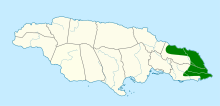Black-billed Jamaican sylph
| Black-billed Jamaican sylph | ||||||||||
|---|---|---|---|---|---|---|---|---|---|---|

Black- billed Jamaican sylph ( Trochilus scitulus ) |
||||||||||
| Systematics | ||||||||||
|
||||||||||
| Scientific name | ||||||||||
| Trochilus scitulus | ||||||||||
| ( Brewster & Bangs , 1901) |
The black- billed Jamaica sylph ( Trochilus scitulus ), also known as the black-billed pennant-tail, is a hummingbird that only occurs in eastern Jamaica . The species used to be considered a subspecies of the pennant tail ( Trochilus polytmus ).
features
The pennant tail and the black-billed Jamaican sylph are examples of allopatric speciation in Jamaica. The species of hummingbird species Trochilus vote in the habit coincide in many features. The beaks, however, are colored differently. Black-billed Jamaican sylphs can be recognized by their 20–24 mm long black beak, the dark long tail feathers and the green, black and blue iridescent plumage . The long, fanned, black tail becomes - as in the pennant tail or the black tail sylph - up to 17 centimeters long. The belly is dark green in color. Their weight is five grams. The female is smaller. Black-billed Jamaica sylphs threaten with loud "ziit" calls.
distribution
The species lives in the east of Jamaica in coastal areas and mountain regions. The distribution area is bounded in the northeast by the Rio Grande and the following John Crow Mountains, in the south by the Morant River.
food
The diet of the black-billed Jamaican sylph consists mainly of flower nectar and pollen . The nectar is absorbed from the flowers in flight. In addition, insects are eaten, which ensures a sufficient supply of protein .
Reproduction
The breeding season is between October and May. The nests are built at a height of 3 to 4 meters. Because of the large amounts of precipitation in the distribution area, the nest material consists of coarser lichens and pieces of roots, among other things. This allows the water to flow off better in heavy rain. The female lays two oval eggs on average. The incubation period is 18 to 20 days.
Enemies
In addition to humans, who destroy the hummingbird's habitat and process parts of this bird into jewelry, the species also has natural enemies such as snakes , cats and birds of prey .
Danger
The entire stock is currently not viewed as threatened. In the Red List of the World Conservation of Nature Union , the black-billed Jamaica sylph is therefore listed in the "LC" (least concern) category.
Etymology and history of research
William Brewster and Outram Bangs described the hummingbird under the name Aithurus scitulus . They gave Priestman's River in Portland Parish as the location . The collector of the type specimen was William Earl Dodge Scott (1852-1910). Only later was it assigned to the genus "Trochilus". This name, which Linnaeus introduced as a new genus in 1758, is historically somewhat problematic. It was already used by Aristotle for a bird that visits the mouth of a crocodile without being injured or even eaten by it. Étienne Geoffroy Saint-Hilaire suspected that Aristotle used it to describe the crocodile guardian ( Pluvianus aegyptius ). Nevertheless, it has become common among scientists to use this term in connection with hummingbirds. "Scitulus" is derived from the Latin word "scitus" for "beautiful".
literature
- Karl-Ludwig Schuchmann : Allopatric speciation in the hummingbird genus Trochilus . In: Ardea . tape 66 , 1978, pp. 156-172 .
- Karl-Ludwig Schuchmann: Hummingbirds: keeping and care . Biotropic-Verlag, Frankfurt am Main 1979, ISBN 978-3-922465-00-3 .
- Gary Russell Graves : Skeletal correlates of body weight in the Black-billed Streamertail (Trochilus scitulus) of Jamaica . In: Caribbean Journal of Science . tape 45 , no. 1 , 2009, p. 69–72 ( online (PDF; 440 kB) [accessed on August 13, 2014]).
- James A. Jobling: Helm Dictionary of Scientific Bird Names . Christopher Helm, London 2010, ISBN 978-1-4081-2501-4 .
- William Brewster, Outram Bangs: On an overlooked species of Aithurus . In: Proceedings of the New England Zoological Club . tape 2 , 1901, p. 47-50 ( online [accessed August 13, 2014]).
- Carl von Linné: Systema Naturae per Regna Tria Naturae, Secundum Classes, Ordines, Genera, Species, Cum Characteribus, Differentiis, Synonymis, Locis . tape 1 . Imprensis Direct Laurentii Salvii, Stockholm 1758 ( online [accessed August 14, 2014]).
- Étienne Geoffroy Saint-Hilaire: Mémoire sur deux espèces d'animaux nommés Trochilus et Bdella par Hérodote, leur guerre, et la part qu'y prend le Crocodile . In: Mémoires du Muséum d'histoire naturelle . tape 15 , 1827, pp. 459-474 ( online [accessed August 14, 2014]).
Web links
- Trochilus scitulus inthe IUCN Red List of Threatened Species 2014.2. Listed by: BirdLife International, 2012. Retrieved August 13, 2014.
- BirdLife International: Species Factsheet - Black-billed Streamertail ( Trochilus scitulus ) . Retrieved August 13, 2014.
- Videos, photos and sound recordings for Black-billed Streamertail (Trochilus scitulus) in the Internet Bird Collection
- Black- billed Jamaican sylph ( Trochilus scitulus ) at Avibase; accessed on August 13, 2014.
- Trochilus scitulus in the Integrated Taxonomic Information System (ITIS). Retrieved August 13, 2014.
- xeno-canto: Sound recordings - Black-billed Streamertail ( Trochilus scitulus )
